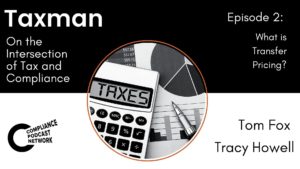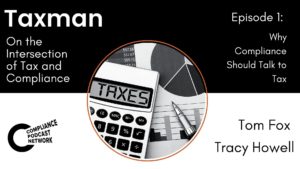What is the intersection of tax and compliance? Why does a Chief Compliance Officer (CCO) or compliance professional need to sit down with the corporate head of tax? How does a corporate tax function fit into a best practices compliance program? It turns out there is quite a bit a compliance professional can learn from a tax professional. Moreover, there are many aspects of tax which should be considered by a CCO and compliance professional from an overall risk management perspective. Unfortunately, these questions are rarely explored in the compliance community.
To explore these issues (and remedy this lack of awareness) I recently sat down with noted tax professional Tracy Howell to explore these and other questions. We tackled these issues and others in a five-part podcast series for Innovation in Compliance. Today, we consider the role of tax in the Supply Chain. We also expand that to compliance, because compliance also has a huge role in this area.
| Obviously, this topic has become more prominent over the last couple of years during the pandemic. Over the past couple of weeks, with the Russia invasion of Ukraine, it has become even more hyper-critical. One of the things we saw in the pandemic was that many companies with long established Supply Chains, perhaps not single source suppliers, but close to single source suppliers, found themselves scrambling when huge swaths. With the Russian invasion of Ukraine, we have had the largest amount of economic sanctions delivered by any administration in the modern era. Companies are struggling with not only responding to the sanctions but responding to the business dislocation from Russia and Belarus to Ukraine and into eastern Europe. Clearly Supply Chain is critical for an organization, especially an organization that manufactures and has any substantial delivery of materials and services. There is also the question of where the highest risk in your Supply Chain might be. Is it in the critical component(s) in the acquisition of goods? Is it in the delivery of services? Or is it simply in the manufacturing process itself? Moreover, if you think of Supply Chains as only having a traditional focus on the acquisition of goods, comprising both the quality of the goods and the cost of the goods, and concluding with the delivery of the goods for consumption or later sale; you are missing a key component. That key component is tax and as Howell stated, “there can be a substantial tax component in each one of those steps of acquisition costs. If you are buying goods in foreign jurisdictions that can be transaction taxes, such as GST or VAT.” Howell provided the following example. “If a company’s buying raw materials in a third country, in the shipping terms, we’d normally say title transfers in international waters, that’s a good thing for the buyer. Because that means if I’m buying something and I take title in international waters, it should not trigger any transaction taxes. However, if you are not paying attention to where you acquire goods from and then you take title within the country of origin’s territory, guess what? That could trigger up to a VAT liability of 15 to 20%. This means that if your Supply Chain is not interacting or does not have a relationship with tax, and the taxes can add a 15% to 20% component to the cost of goods in a transaction, which dramatically impacts the company’s cost of goods sold (COGS).” However, if there is a good relationship between tax and Supply Chain, there can also be additional benefits tax brought to the fore and such benefits are more critical in 2022 and beyond because they can help a company plan for disruptions in the supply chain. For instance, if Supply Chain looks for alternative suppliers, or a different geo-region for component parts, tax can step in and do an analysis that would at least give them an estimate of what the tax costs are going to be. Howell said that tax can provide “Supply Chain with the data that is beyond the cost of good, or the cost of material, or the cost of service. A tax professional can do so by modeling out the liability that a multinational could incur, including up to five different possible sources for goods and materials. From there you can extend your model out to see what the additional tax burden would be in each one of those scenarios. From there you can check to see if there are any tax incentives that either exist or that your organization can go negotiate.” But the risk management that tax can bring to Supply Chain does not end there; particularly once tax and Supply Chain have established a relationship and it is understood how tax can assist Supply Chain in the procurement of goods and services. Through a documented process, it creates and entire framework for the organization to use going forward because at any given time Supply Chain will be looking for goods and services in different locations. Howell said, “you can have a mission creep. It is important for tax to have that relationship with Supply Chain so as their functionality changes and your organization is acquiring new goods in different locations, you can document the changes, and update your framework as needed when new tax issues can come to play.” |
Join us tomorrow for our concluding post when we consider the role of tax in a corporate ESG program. Check out the full podcast series Taxman: On the Intersection of Tax and Compliance on the Compliance Podcast Network. Check out Tracy Howell on LinkedIn.








